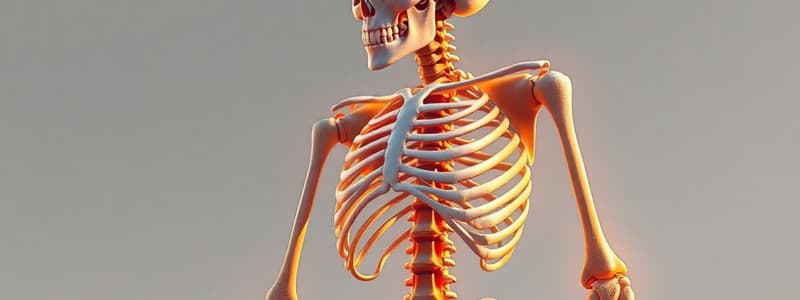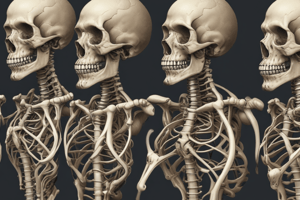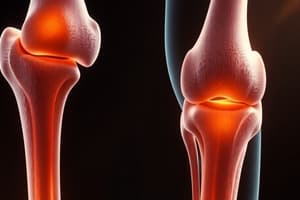Podcast
Questions and Answers
Which type of joint allows for very little or no movement?
Which type of joint allows for very little or no movement?
- Hinge joints
- Cartilaginous joints (correct)
- Synovial joints
- Fibrous joints (correct)
Articulations can also be referred to as synarthroses.
Articulations can also be referred to as synarthroses.
False (B)
What is the primary connective tissue found in fibrous joints?
What is the primary connective tissue found in fibrous joints?
dense irregular connective tissue
The scientific study of joints is known as _______.
The scientific study of joints is known as _______.
What connects cranial bones through thin strips of connective tissue?
What connects cranial bones through thin strips of connective tissue?
Match the type of joint with its description:
Match the type of joint with its description:
Syndesmoses allow for a greater range of movement compared to sutures.
Syndesmoses allow for a greater range of movement compared to sutures.
A ________ is a specialized cone-shaped syndesmosis between a tooth and the mandible or maxilla.
A ________ is a specialized cone-shaped syndesmosis between a tooth and the mandible or maxilla.
What type of cartilage covers the bones in synovial joints?
What type of cartilage covers the bones in synovial joints?
Synovial fluid only serves to lubricate joints.
Synovial fluid only serves to lubricate joints.
What is the function of the synovial membrane?
What is the function of the synovial membrane?
Bursae reduce friction between ________ and soft tissue.
Bursae reduce friction between ________ and soft tissue.
Match the type of synovial joint to its movement characteristics:
Match the type of synovial joint to its movement characteristics:
Which type of joint allows for the greatest range of motion?
Which type of joint allows for the greatest range of motion?
Bursitis refers to inflammation of cartilage.
Bursitis refers to inflammation of cartilage.
What movements are included under angular movements?
What movements are included under angular movements?
Individuals with increased flexibility around joints are often referred to as '______-jointed'.
Individuals with increased flexibility around joints are often referred to as '______-jointed'.
Which type of joint is characterized by gliding movements?
Which type of joint is characterized by gliding movements?
The articular capsule consists of a fibrous layer and a synovial membrane.
The articular capsule consists of a fibrous layer and a synovial membrane.
What is the primary role of accessory ligaments in synovial joints?
What is the primary role of accessory ligaments in synovial joints?
_________ movements are unique to certain joints, such as the temporomandibular joint.
_________ movements are unique to certain joints, such as the temporomandibular joint.
Which joint type primarily allows for flexion and extension?
Which joint type primarily allows for flexion and extension?
Which type of joint permits the greatest mobility?
Which type of joint permits the greatest mobility?
The temporomandibular joint (TMJ) is solely a hinge joint.
The temporomandibular joint (TMJ) is solely a hinge joint.
What is the primary function of the glenoid labrum in the shoulder joint?
What is the primary function of the glenoid labrum in the shoulder joint?
The knee joint is a ________ modified ________ joint.
The knee joint is a ________ modified ________ joint.
Match each joint with its corresponding classification or description:
Match each joint with its corresponding classification or description:
What type of movement is NOT permitted in ball-and-socket joints?
What type of movement is NOT permitted in ball-and-socket joints?
Osteoarthritis is characterized by the progressive loss of synovial fluid.
Osteoarthritis is characterized by the progressive loss of synovial fluid.
Name the bones that form the elbow joint.
Name the bones that form the elbow joint.
The movement permitted around the shoulder joint includes ________ rotation.
The movement permitted around the shoulder joint includes ________ rotation.
Match the following components of the knee joint to their functions:
Match the following components of the knee joint to their functions:
What term describes the common treatment for sprains?
What term describes the common treatment for sprains?
The hip joint is considered less stable than the shoulder joint due to its ligament arrangement.
The hip joint is considered less stable than the shoulder joint due to its ligament arrangement.
What is the main role of the ligaments in the elbow joint?
What is the main role of the ligaments in the elbow joint?
Sprains involve the ________ of ligaments, while strains involve muscles or tendons.
Sprains involve the ________ of ligaments, while strains involve muscles or tendons.
Flashcards are hidden until you start studying
Study Notes
Introduction to Joints
- Joints are also known as articulations or arthroses
- Joints are sites where bones come together
- Arthrology is the study of joints
Classification of Joints
- Joints are classified based on their structure
- Two key questions to determine structural class:
- Does the joint have an articular cavity between the articulating bones?
- What type of connective tissue connects the bones of the joint?
Fibrous Joints
- Bones are joined by dense irregular connective tissue
- No articular cavity
- Generally immobile
- Three types:
- Sutures: Connect cranial bones with thin strips of dense irregular connective tissue
- In adults, sutures become synarthroses, meaning they fuse together
- Synosis is the early fusion of two bones in the skull
- Syndesmoses: Thicker and longer strips of dense irregular connective tissue
- Interosseous ligament/membrane connects bones
- Gomphosis: Cone-shaped joint between teeth and the mandible or maxilla
- Interosseous membranes: Made of dense irregular connective tissue
- Holds diaphyses of adjacent long bones together
- Sutures: Connect cranial bones with thin strips of dense irregular connective tissue
Cartilaginous Joints
- Bones are joined by cartilage
- No articular cavity
- Little or no movement
- Two subtypes:
- Synchondroses: Connects bones with hyaline or fibrocartilage cartilage
- Epiphyseal cartilages, made of hyaline cartilage, allow for bone growth
- Symphyses: Held by fibrocartilage
- Bones are still covered in hyaline cartilage at articular surfaces
- Synchondroses: Connects bones with hyaline or fibrocartilage cartilage
Synovial Joints
- Distinguished by presence of articular cavity between bones
- Bounded by articular capsule
- Secretes lubricating fluid
- Bones covered in articular cartilages
- Hyaline cartilage, does NOT bind bones
- Freely moveable
- Articular capsule surrounds synovial joints
- Two layers:
- Fibrous layer (outer): Dense irregular connective tissue, attaches to periosteum, forms ligaments at some joints
- Synovial membrane (inner): Areolar connective tissue, secretes synovial fluid
- Viscous, clear or pale yellow
- Nourishes chondrocytes of articular cartilage
- Contains oxygen and nutrients
- Contains immune cells
- Reduces friction between bones at joints
- Absorbs shock
- Two layers:
- "Double-jointed" individuals have increased flexibility around the articular capsule and ligaments of joints
- Increased risk for dislocation
- Joints are not actually doubled
- Other components of synovial joints:
- Accessory ligaments: Provide extra reinforcement for synovial joints
- Articular discs or menisci: Fibrocartilage padding attached to the inside surface of the fibrous capsule
- Absorb shock and distribute weight more evenly
- Bursae reduce friction between moving structures
- Share a similar structure with articular capsules
- Found between bones and soft tissue
- Bursitis is chronic inflammation of bursae
- Tendon sheaths also reduce friction between structures
- Tube-shaped bursae
- Wrap around tendons that experience a lot of friction
Movements
- Only synovial joints are freely moveable
- Four main categories of movement:
- Gliding: Nearly flat bones slide back-and-forth and side-to-side
- No change in angle between articulating bones
- Angular movements: Increase or decrease angles between articulating bones
- Flexion: Decrease in angle between joined bones
- Extension: Increase in angle between joined bones
- Lateral flexion: Decrease in angle between bones in the coronal plane
- Abduction: Movement of a bone away from a midline
- Adduction: Movement toward the midline
- Circumduction: Movement around a joint to move the distal part of a limb in a circle
- Combines flexion, extension, abduction, and adduction
- Hyperextension: Extending a joint beyond its normal range of motion
- Rotation: Turning of a bone along its longitudinal axis
- May be medial or lateral in the limbs
- Special movements: Movements unique to specific joints
- Mandible: Elevation, depression, protraction, retraction
- Hands and feet: Dorsiflexion, plantar flexion, inversion, eversion, supination, pronation
- Opposition: Movement of the pollex (thumb) to touch other fingers
- Gliding: Nearly flat bones slide back-and-forth and side-to-side
Types of Synovial Joints
- Six types:
- Plane joints: Permit gliding, movements are biaxial
- Intercarpal or -tarsal joints, sternoclavicular joints, vertebrocostal joints
- Hinge joints: Movement is uniaxial (flexion/extension)
- Knee joints, elbow joints, ankle joints, interphalangeal joints
- Pivot joints: Rounded surface of one bone fitted to a ligament + other bone, permits uniaxial movement
- Atlanto-axial joint (shake your head no), radioulnar joints (supination/pronation)
- Condyloid joints: Oval-shaped protrusion fits an oval-shaped depression, permits biaxial movement (flexion/extension, abduction/adduction, or circumduction)
- Radiocarpal joints (wrist)
- Saddle joints: One bone looks like a saddle and the other looks like a rider, biaxial movement (flexion/extension, abduction/adduction, or circumduction)
- Carpometacarpal joint between proximal metacarpal of the thumb and trapezium
- Ball-and-socket joints: Ball-shaped projection fits into a cup-shaped depression, permits triaxial movement (flexion/extension, abduction/adduction, circumduction, rotation)
- Shoulder and hip joints
- Plane joints: Permit gliding, movements are biaxial
Special Examples of Joints
- Temporomandibular joint (TMJ):
- Only freely moveable joint in the skull
- Combination hinge and plane joints
- Articulation between the condylar process of the mandible and mandibular fossa of the temporal bone
- Articular components:
- Articular capsule
- Multiple ligaments stabilize joint
- Meniscus subdivides synovial cavity into superior and inferior compartments
- Superior: Permits slight rotation, lateral displacement, protraction/retraction
- Inferior: Permits depression/elevation
- Movements permitted:
- Depression/elevation
- Protraction and retraction
- Lateral displacement (side to side)
- Some rotation
- Glenohumeral joint (shoulder):
- Ball-and-socket joint
- Thin, loose articular capsule
- Articular components:
- Many ligaments reinforce the joint
- Glenoid labrum: Fibrocartilage lip of the glenoid cavity
- Increases surface area of glenoid cavity in contact with humeral head
- Bursae: Four pads to absorb shock and reduce friction
- Movements:
- Flexion, extension, hyperextension
- Abduction, adduction
- Medial and lateral rotation
- Circumduction
- Great ROM but less stable than the coxal joint
- Elbow joint:
- Formed by humerus, ulna, and radius
- Articular components:
- Articular capsule
- Collateral ligaments: Accessory ligaments connecting humerus and radius or ulna
- Annular ligament: Ring-like ligament holding radial head to radial notch of the ulna
- Bursa at the olecranon
- Movement:
- Flexion or extension
- Coxal or hip joint:
- Ball-and-socket joint formed by the acetabulum of the coxal bone + head of the femur
- Very stable joint due to:
- Number and arrangement of ligaments
- Specific fit of the femoral head in the acetabulum
- Articular components:
- Thick articular capsule
- Acetabular labrum: Fibrocartilage lip of the acetabulum
- Accessory ligaments: Numerous and strong
- Makes hip joint one of the strongest in the body
- Reinforces articular capsule but limits ROM compared to shoulder joint
- Movements:
- Flexion/extension
- Abduction/adduction
- Lateral and medial rotation
- Circumduction
- Knee joint:
- Modified hinge joint
- Three joints sharing one synovial cavity:
- Lateral joint between femur and tibia
- Medial joint between femur and tibia
- Anterior patellofemoral joint (a plane joint)
- Articular components:
- No single identifiable articular capsule
- Collection of muscle tendons serves similar function
- Cruciate ligaments: Accessory ligaments that cross one another
- Collateral ligaments: Reinforce connection between femur + tibia, femur + fibula
- Menisci: One medial, one lateral
- Bursae: A few, including the infrapatellar bursa
- Movements:
- Flexion/extension
- Some rotation
- Limited abduction/adduction
Joint Diseases and Disorders
- Arthritis:
- Osteoarthritis: Progressive loss of articular cartilage, resulting in increased friction between bones
- Sprains and strains:
- Sprains: Forceful stretching or tearing of ligaments
- Strains: Partially torn or stretched muscle or tendon
- Treatment = PRICE (Protection, rest, ice, compression, elevation)
Summary
- Joints are sites of contact between bones
- Classified by structure or function
- Synovial joints are the only freely moveable joints
- Movements permitted around joints are a consequence of synovial joint structure
- Joint diseases or disorders may be treated with PRICE or with surgery
Studying That Suits You
Use AI to generate personalized quizzes and flashcards to suit your learning preferences.




